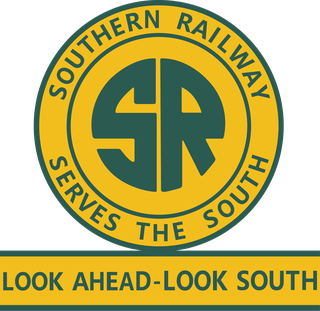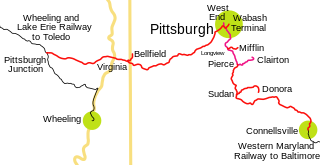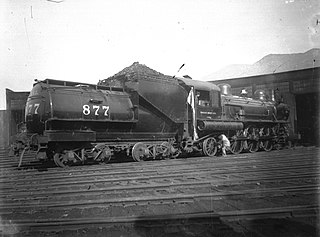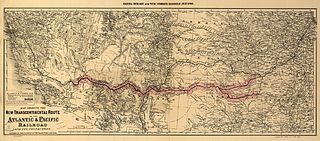Related Research Articles

The Interstate Commerce Commission (ICC) was a regulatory agency in the United States created by the Interstate Commerce Act of 1887. The agency's original purpose was to regulate railroads to ensure fair rates, to eliminate rate discrimination, and to regulate other aspects of common carriers, including interstate bus lines and telephone companies. Congress expanded ICC authority to regulate other modes of commerce beginning in 1906. Throughout the 20th century, several of ICC's authorities were transferred to other federal agencies. The ICC was abolished in 1995, and its remaining functions were transferred to the Surface Transportation Board.

The Chicago, Milwaukee, St. Paul and Pacific Railroad (CMStP&P), better known as the Milwaukee Road, was a Class I railroad that operated in the Midwest and Northwest of the United States from 1847 until 1986.

Union Pacific Corporation is a publicly traded railroad holding company. It was incorporated in Utah in 1969 and is headquartered in Omaha, Nebraska. It is the parent company of the current, Delaware-registered, form of the Union Pacific Railroad, and the company, along with Berkshire Hathaway-owned rival BNSF, has a near-duopoly on freight railroad transportation west of the Mississippi River.

The Southern Railway was a class 1 railroad based in the Southern United States between 1894 and 1982, when it merged with the Norfolk and Western Railway (N&W) to form the Norfolk Southern Railway. The railroad was the product of nearly 150 predecessor lines that were combined, reorganized and recombined beginning in the 1830s, formally becoming the Southern Railway in 1894.

The Missouri Pacific Railroad, commonly abbreviated as MoPac, was one of the first railroads in the United States west of the Mississippi River. MoPac was a Class I railroad growing from dozens of predecessors and mergers. In 1967, the railroad operated 9,041 miles of road and 13,318 miles of track, not including DK&S, NO&LC, T&P, and its subsidiaries C&EI and Missouri-Illinois.

The Grand Trunk Western Railroad Company was an American subsidiary of the Grand Trunk Railway, later of the Canadian National Railway operating in Michigan, Illinois, Indiana, and Ohio. Since a corporate restructuring in 1971, the railroad has been under CN's subsidiary holding company, the Grand Trunk Corporation. Grand Trunk Western's routes are part of CN's Michigan Division. Its primary mainline between Chicago and Port Huron, Michigan serves as a connection between railroad interchanges in Chicago and rail lines in eastern Canada and the Northeastern United States. The railroad's extensive trackage in Detroit and across southern Michigan has made it an essential link for the automotive industry as a hauler of parts and automobiles from manufacturing plants.
The Baltimore and Ohio Chicago Terminal Railroad is a terminal railroad in the Chicago area, formerly giving various other companies access to (Chicago's) Grand Central Station. It also served to connect those railroads for freight transfers, and is now controlled by CSX Corporation, the successor to the Baltimore and Ohio Railroad.

The Pittsburgh and West Virginia Railway was a railroad in the Pittsburgh, Pennsylvania, and Wheeling, West Virginia, areas. Originally built as the Wabash Pittsburgh Terminal Railway, a Pittsburgh extension of George J. Gould's Wabash Railroad, the venture entered receivership in 1908 and the line was cut loose. An extension completed in 1931 connected it to the Western Maryland Railway at Connellsville, Pennsylvania, forming part of the Alphabet Route, a coalition of independent lines between the Northeastern United States and the Midwest. It was leased by the Norfolk and Western Railway in 1964 in conjunction with the N&W acquiring several other sections of the former Alphabet Route, but was leased to the new spinoff Wheeling and Lake Erie Railway in 1990, just months before the N&W was merged into the Norfolk Southern Railway.

The Oregon Short Line Railroad was a railroad in Wyoming, Idaho, Utah, Montana and Oregon in the United States. The line was organized as the Oregon Short Line Railway in 1881 as a subsidiary of the Union Pacific Railway. The Union Pacific intended the line to be the shortest route from Wyoming to Oregon and the Pacific Northwest. Construction was begun in 1881 at Granger, Wyoming, and completed in 1884 at Huntington, Oregon. In 1889 the line merged with the Utah & Northern Railway and a handful of smaller railroads to become the Oregon Short Line and Utah Northern Railway. Following the bankruptcy of Union Pacific in 1897, the line was taken into receivership and reorganized as the Oregon Short Line Railroad (“OSL”). The OSL became a part of the Union Pacific System in the Harriman reorganization of 1898.

The Atlantic and Pacific Railroad was a U.S. railroad that owned or operated two disjointed segments, one connecting St. Louis, Missouri with Tulsa, Oklahoma, and the other connecting Albuquerque, New Mexico with Needles in Southern California. It was incorporated by the U.S. Congress in 1866 as a transcontinental railroad connecting Springfield, Missouri and Van Buren, Arkansas with California. The central portion was never constructed, and the two halves later became parts of the St. Louis-San Francisco Railway and Atchison, Topeka and Santa Fe Railway systems, now both merged into the BNSF Railway.
The Youngstown and Southeastern Railroad is a short-line railroad subsidiary of Midwest & Bluegrass Rail that operates freight trains between Youngstown, Ohio and Darlington, Pennsylvania, United States. The line is owned by the Columbiana County Port Authority, leased to the Eastern States Railroad, which is owned by the line's primary shipper, and contracted out to the YSRR. Freight is interchanged with CSX Transportation and the Norfolk Southern Railway at the Youngstown end.
The following is a brief history of the North American rail system, mainly through major changes to Class I railroads, the largest class by operating revenue.
The following is a brief history of the North American rail system, mainly through major changes to Class I railroads, the largest class by operating revenue.

The Oregon Eastern Railway was a predecessor of the Southern Pacific Company that acquired or built most of the Natron Cutoff in northern California and southern Oregon, United States. It also made surveys and acquired right-of-way in eastern Oregon, which were subsequently sold to Union Pacific Railroad subsidiary Oregon–Washington Railroad and Navigation Company.

The Chicago Junction Railway operated a switching and terminal railroad in Chicago, connecting the Union Stock Yards with most other railroads in the city. It also briefly operated an outer belt, which became the Indiana Harbor Belt Railroad in 1907. The New York Central Railroad acquired control of the company in 1922 and leased it to subsidiary Chicago River and Indiana Railroad. The line is now owned and operated by the Norfolk Southern Railway.
The Baltimore and Ohio and Chicago Railroad (B&O&C) was a subsidiary of the Baltimore and Ohio Railroad (B&O) that owned the line from Willard, Ohio to Chicago, Illinois.

The Wabash Railroad was a Class I railroad that operated in the mid-central United States. It served a large area, including track in the states of Ohio, Indiana, Illinois, Iowa, Michigan, and Missouri and the province of Ontario. Its primary connections included Chicago, Illinois; Kansas City, Missouri; Detroit, Michigan; Buffalo, New York; St. Louis, Missouri; and Toledo, Ohio.
The Selma and Meridian Rail Road Company was incorporated under special act of Alabama on February 7, 1850, as The Alabama and Mississippi Rivers Rail Road Company. On November 29, 1864, the name of the company was changed to The Selma and Meridian Rail Road Company.
Atlantic and North Carolina Railroad Company was incorporated under act of the North Carolina Legislature, ratified December 27, 1852, and was organized on January 20, 1854.
References
- Interstate Commerce Commission, Annual Report on the Statistics of Railways in the United States, 1910-
- Edward A. Lewis, American Shortline Railway Guide, 5th Edition, Kalmbach Publishing, 1996
- Moody's Transportation Manual
- ↑ ICC (1932), p. 219
- 1 2 3 Moody's (1990), p. 286
- ↑ Moody's (1992), p. 234
- 1 2 Moody's (1976), p. 274
- 1 2 Moody's (1990), p. 277
- 1 2 ICC (1931)
- ↑ ICC (1930)
- 1 2 3 4 5 6 7 8 9 10 11 12 Christopher T. Baer, PRR Chronology (Pennsylvania Railroad Technical and Historical Society), accessed April 2009
- ↑ George C. Werner: Rock Island System from the Handbook of Texas Online. Retrieved April 2009.
- ↑ ICC (1920), p. 437
- 1 2 3 George C. Werner: Burlington-Rock Island Railroad from the Handbook of Texas Online. Retrieved April 2009.
- ↑ Oliphant's Earning Power of Railroads, 1946, p. 160
- ↑ ICC (1922)
- 1 2 3 4 5 6 ICC (1949)
- ↑ Oliphant's Earning Power of Railroads, 1946, pp. 191-192
- ↑ Moody's (1970), p. xli
- ↑ Moody's (1976), p. 755
- ↑ Moody's (1992), p. 257
- ↑ Moody's (1982), p. 83
- 1 2 ICC (1933)
- ↑ Oliphant's Earning Power of Railroads, 1946, pp. 361-362
- 1 2 3 ICC (1934)
- ↑ Howard C. Williams: Texas and New Orleans Railroad from the Handbook of Texas Online. Retrieved April 2009.
- ↑ Moody's (1984), p. 647
- ↑ Moody's (1976), p. 261
- 1 2 3 ICC (1935)
- 1 2 3 ICC (1937)
- ↑ Moody's (1992), p. 111
- 1 2 3 Paul Stringham, Illinois Terminal, the Electric Years, ISBN 0-916374-82-3, pp. 98, 251
- ↑ Patricia L. Duncan: Fort Worth and Rio Grande Railway from the Handbook of Texas Online. Retrieved April 2009.
- ↑ ICC (1938)
- 1 2 3 4 5 ICC (1939)
- ↑ Moody's (1986), p. 670
- 1 2 Nancy Beck Young: Chicago, Rock Island and Gulf Railway from the Handbook of Texas Online. Retrieved April 2009.
- ↑ Moody's (1992), p. 79
- 1 2 Moody's (1972), p. 295
- ↑ Moody's (1976), p. 644
- 1 2 H. Allen Anderson: Wichita Falls and Southern Railroad from the Handbook of Texas Online. Retrieved April 2009.
- ↑ Oliphant's Earning Power of Railroads, 1946, p. 251
- 1 2 3 4 5 6 Moody's (1992), p. 403
- 1 2 Moody's (1976), p. 407
- ↑ Moody's (1969), p. 684
- ↑ ICC (1941)
- ↑ Moody's (1990), p. 63
- ↑ Moody's (1971), p. 55
- ↑ ICC (1940)
- ↑ Moody's (1976), p. 310
- 1 2 3 ICC (1943)
- ↑ ICC (1923)
- ↑ Moody's (1989), p. 296
- ↑ Oliphant's Earning Power of Railroads, 1946, p. 154
- ↑ Oliphant's Earning Power of Railroads, 1946, p. 118
- ↑ ICC (1942)
- ↑ Moody's (1986), p. 677
- 1 2 Moody's (1986), p. 662
- ↑ Moody's (1982), p. 1260
- ↑ ICC (1926)
- 1 2 Moody's (1972), p. 278
- ↑ Moody's (1976), p. 604
- ↑ Moody's (1975), p. 131
- ↑ Moody's (1971), p. 357
- 1 2 Moody's (1988), p. 251
- ↑ ICC (1945)
- ↑ Moody's (1975), p. 141
- ↑ Moody's (1990), p. 205, 231
- ↑ Pennsylvania Railroad Board of Directors, Inspection of Physical Property, November 1948, pp. 122-128
- ↑ ICC (1920), p. 422
- 1 2 ICC (1946)
- ↑ R. A. LeMassena (1974). Rio Grande ... to the Pacific!. Sundance Publications. ISBN 0-913582-09-3., pp. 139, 149, 163
- 1 2 Moody's (1986), p. 89
- ↑ Moody's (1986), p. 647
- ↑ Moody's (1976), p. 110
- ↑ Moody's (1985), p. 883
- 1 2 3 ICC (1947)
- 1 2 3 4 ICC (1948)
- ↑ Moody's (1976), p. 116
- 1 2 Moody's (1980), p. 788
- ↑ George C. Werner: Gulf, Colorado and Santa Fe Railway from the Handbook of Texas Online. Retrieved April 2009.
- 1 2 3 Moody's (1984), p. 96
- 1 2 Moody's (1988), p. 237
- 1 2 ICC (1950)
- ↑ ICC (1936)
- 1 2 3 Moody's (1984), pp. 97, 142
- ↑ Moody's (1982), p. 33
- ↑ Chris Cravens: Wichita Valley Railway from the Handbook of Texas Online. Retrieved April 2009.
- ↑ Moody's (1982), p. 845
- ↑ Moody's (1975), p. 567
- ↑ Moody's (1976), p. 764
- ↑ ICC (1946, 1956)
- ↑ Moody's (1984), p. 664
- ↑ Moody's (1992), pp. 257-258
- ↑ Moody's (1972), p. 37
- ↑ Moody's (1972), p. 98
- 1 2 3 4 Moody's (1992), p. 122
- 1 2 Moody's (1976), p. 1203
- ↑ ICC (1955, 1956)
- 1 2 3 Moody's (1984), p. 28
- ↑ Moody's (1985), p. 701
- 1 2 Moody's (1989), p. 30
- ↑ Moody's (1971), p. 102
- ↑ Moody's (1989), p. 71
- ↑ Moody's (1969), p. 535
- ↑ Moody's (1976), p. 111
- ↑ ICC (1929, 1930)
- ↑ Moody's (1986), p. 746
- 1 2 Moody's (1972), p. 837
- ↑ Moody's (1976), p. 209
- ↑ Moody's (1989), p. 330
- ↑ Moody's (1988), p. 72
- 1 2 Moody's (1986), p. 663
- ↑ ICC (1963), p. 498
- ↑ ICC (1952), p. 152
- 1 2 Moody's (1982), p. 852
- ↑ David Minor: St. Louis, San Francisco and Texas Railway from the Handbook of Texas Online. Retrieved April 2009.
- ↑ Moody's (1992), p. 407
- ↑ Moody's (1969), p. xxxvii
- 1 2 3 Moody's (1976), p. 656
- 1 2 ICC (1966)
- ↑ Moody's (1992), p. 258
- ↑ ICC (1964, 1965)
- ↑ Moody's (1975), p. xxx
- ↑ Moody's (1992), p. 97
- ↑ Moody's (1975), p. 566
- 1 2 3 Moody's (1976), p. 224
- ↑ Moody's (1992), p. 423
- ↑ Moody's (1990), p. 335
- ↑ Moody's (1980), p. 752
- ↑ Moody's (1992), p. 12
- ↑ Moody's (1984), p. 125
- 1 2 Moody's (1992), p. 539
- ↑ Moody's (1992), p. 203
- ↑ Moody's (1982), p. 711
- ↑ Moody's (1988), p. 298
- ↑ Moody's (1992), p. 415
- ↑ Moody's (1992), p. 32
- ↑ Lewis, p. 257
- ↑ Moody's (1986), p. 649
- ↑ ICC (1975, 1976)